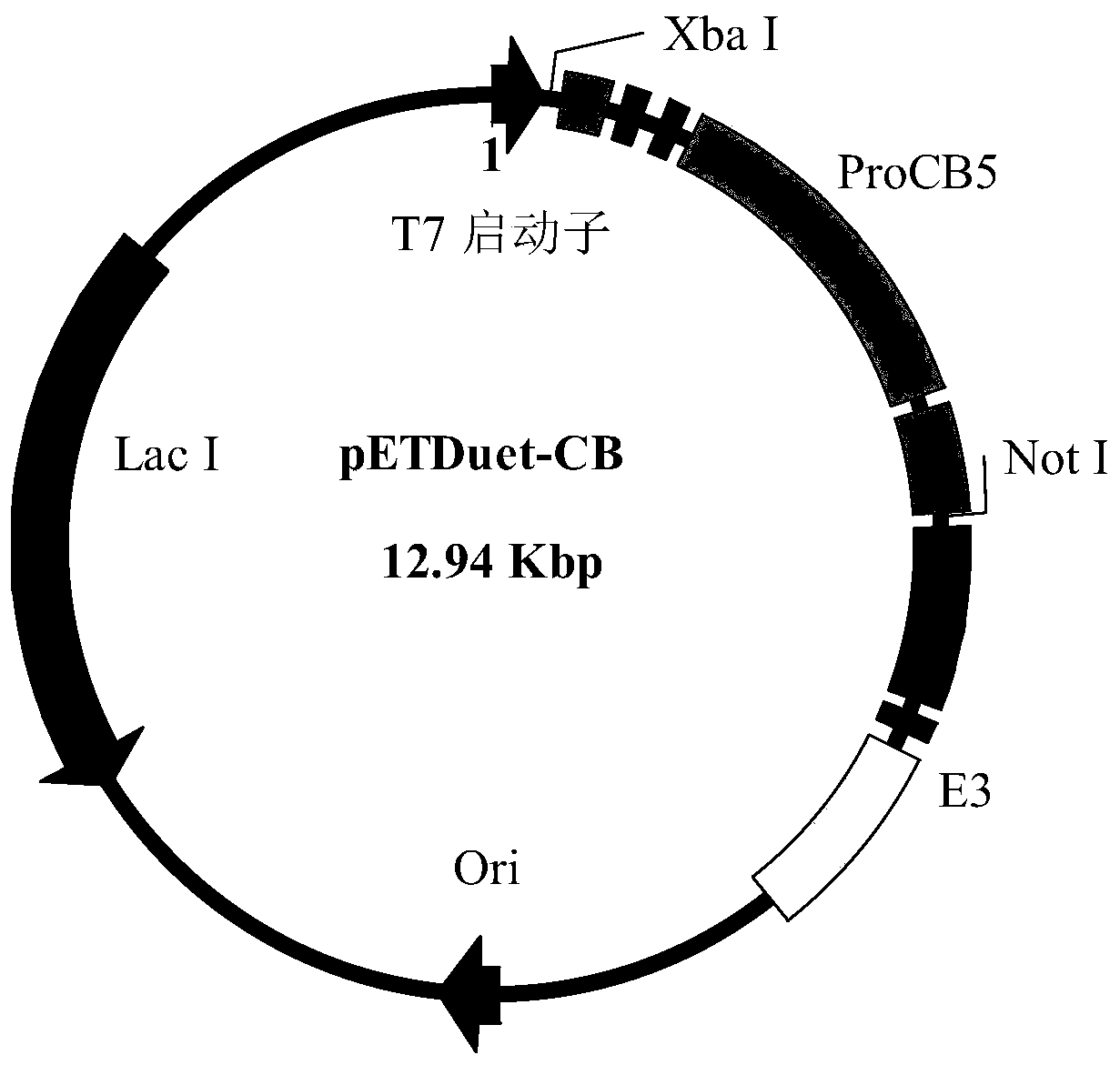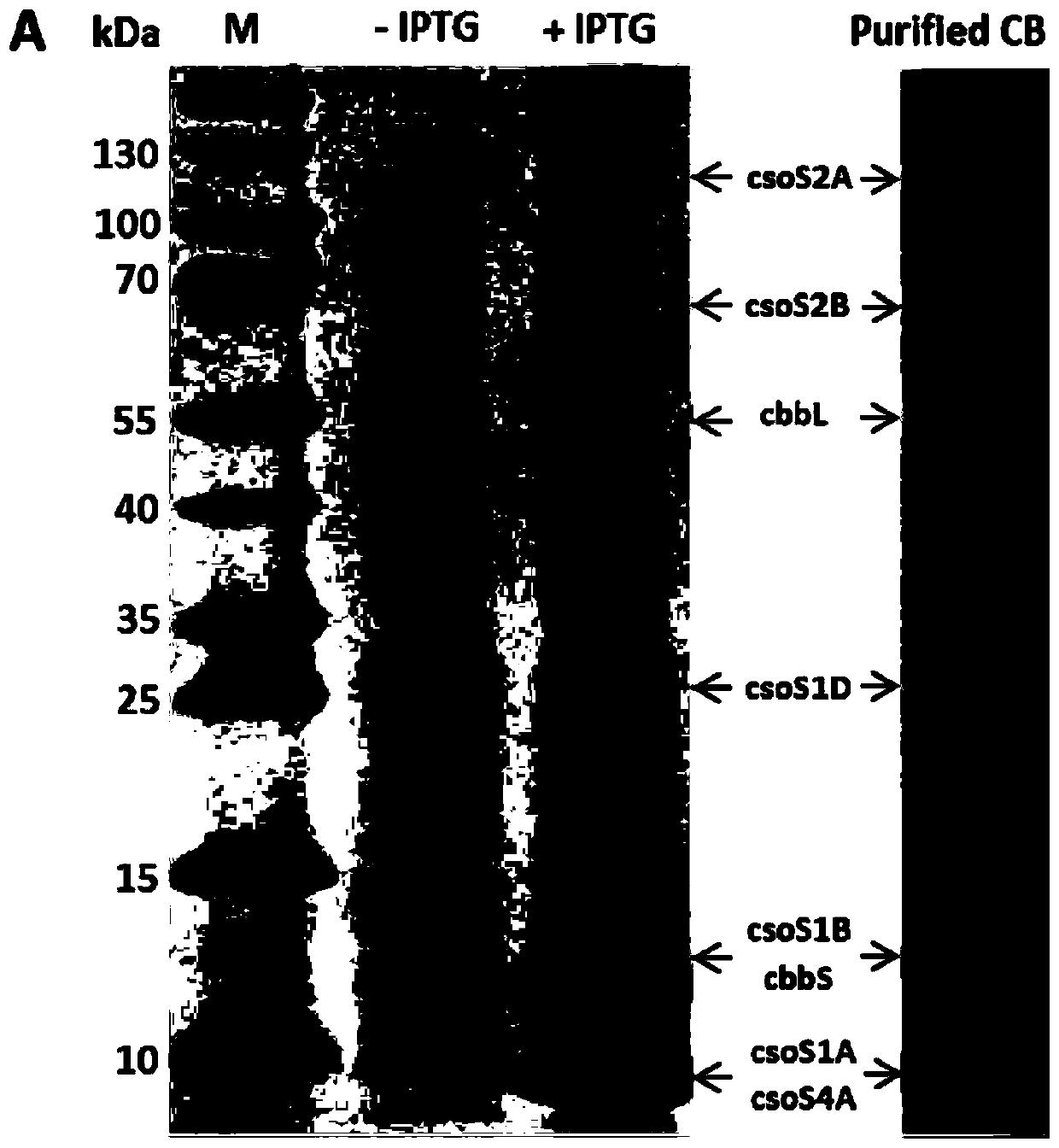Synthesis of CO2 immobilized class organelle in bacteria and application thereof
A technology of organelles and types, which is applied in the synthesis and application of CO2-fixed organelles in bacteria, which can solve problems such as global warming, destruction of global ecological balance, and increase in concentration, and achieve high-efficiency fixation
- Summary
- Abstract
- Description
- Claims
- Application Information
AI Technical Summary
Problems solved by technology
Method used
Image
Examples
Embodiment 1
[0068] Embodiment 1 class organelle synthesis
[0069] The genes required for organelle synthesis provided in this example include capsid protein csoS1, csoS2, csoS4A / B, csoS1D protein, ribulose-1,5-bisphosphate carboxylase (RuBisCO) and participation in CO 2 and HCO 3 - The carbonic anhydrase csoSCA gene that transforms between each other is derived from the model strain Prochlorococcus MED4, and its gene cluster distribution is as follows: figure 1 shown.
[0070] Coding gene clusters of capsid proteins csoS1 (PMM0549), csoS4A / B (PMM0554 / PM0555), csoS2 (PMM0552), and csoS1D (PMM0547) derived from the synthetic model strain Prochlorococcus MED4 (NC_005072.1), At the same time, the respective ribosome binding sites (RBS) are retained to simulate their expression in the host bacteria; the gene fragments synthesized in series are introduced into the engineered prokaryotic expression vector pETDuet-1 by means of molecular cloning to construct prokaryotic expression Vector pET...
Embodiment 2
[0080] Example 2 Expression and analysis of multicomponent organelles
[0081] Transfer the BL21 of the expression vector pETDuet-CB constructed in Example 1 capable of expressing organelle-like components (csoS1, cbbl, cbbs, csoS2, csoSCA, csoS4A / B and csoS1D) to LB medium, and expand the culture to the logarithmic phase (OD600=about 0.6), and then add the inducer IPTG to the culture medium, and induce the expression for 10 hours at 25°C. Then collect the bacteria, generally about 6-8g bacteria, and use about 75ml of TEMB buffer to resuspend (TEMB: 10mM Tris-HCl, 10mMMgCl 2 , 20mM NaHCO 3 , 1mM EDTA, pH8.0); then crush, you can choose ultrasonic crushing, or you can use a pressure crushing instrument to crush the bacteria. It is required to be crushed sufficiently and can be crushed repeatedly. During the crushing process, an appropriate amount of protease inhibitors can also be added to avoid degradation of the target protein. ; Centrifuge the crushed sample at 12.000g for...
Embodiment 3
[0083] Example 3 Using Molecular Chaperones to Assist the Synthesis of Organelles
[0084] Introduction and characterization of organelle-like self-assembly chaperones: Molecular cloning was used to introduce molecular chaperones, such as GroEL / S, RbcX, Raf1, Hsp70, Hsp60, Hsp68, DnaK / DnaJ, Bip, Hsc1, Hsc2, Hsc4 or Hsc70, Nuclein, T receptor binding protein (TRAP), E. coli SecB and trigger factor and PapD, phage-encoded scaffolding protein, etc.
[0085] In this example, GroEL / S and RbcX were selected as molecular chaperones. The complete gene sequence of the synthetic molecular chaperone RbcX (Nature Structural and Molecular Biology 22.9(2015):720; Cell 129.6(2007):1189-1200) was introduced into the engineering vector pCDFDuet-1 by means of molecular cloning to form the plasmid pCDFDuet-RbcX. The specific process is as follows:
[0086] Using the artificially synthesized RbcX gene sequence as a template, primers RbcX-F and RbcX-R were used for PCR amplification to obtain th...
PUM
 Login to View More
Login to View More Abstract
Description
Claims
Application Information
 Login to View More
Login to View More - R&D
- Intellectual Property
- Life Sciences
- Materials
- Tech Scout
- Unparalleled Data Quality
- Higher Quality Content
- 60% Fewer Hallucinations
Browse by: Latest US Patents, China's latest patents, Technical Efficacy Thesaurus, Application Domain, Technology Topic, Popular Technical Reports.
© 2025 PatSnap. All rights reserved.Legal|Privacy policy|Modern Slavery Act Transparency Statement|Sitemap|About US| Contact US: help@patsnap.com



